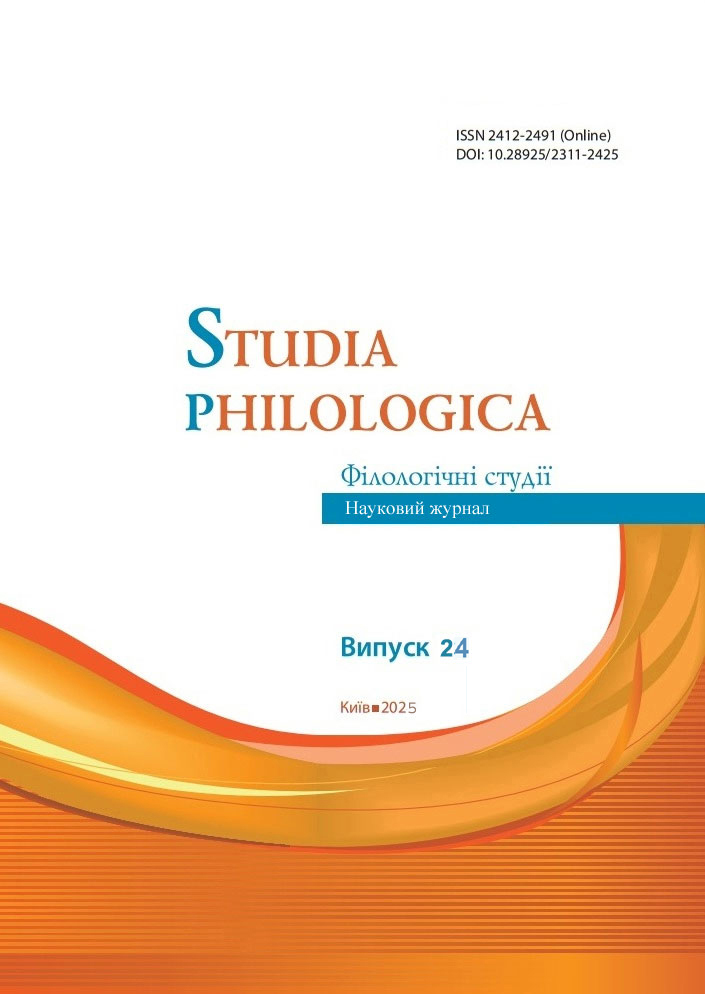Metaphor as a Pragmatic Tool for Stylistic Enhancement: Cognitive and Translation Studies Perspectives
DOI:
https://doi.org/10.28925/2311-2425.2025.2417Keywords:
metaphor, linguistic expression, pragmatic tool, translation studies, cognitive approach, communicationAbstract
Among the myriad tools of linguistic expression, metaphor stands out as a potent means of enriching language and influencing audiences. This paper explores metaphor as a pragmatic tool for stylistic enhancement, drawing insights from cognitive theory and translation studies.
Traditionally, research on metaphor was primarily linguistic. However, in the latter half of the 20th century, scholars shifted towards understanding metaphor as a reflection of cognitive processes and a mechanism for structuring human concepts. The objective of this article is to define metaphor as a pragmatic means of stylistic expression and to elucidate its various functions within texts.
A cognitive approach to metaphor, championed by researchers from both national and international backgrounds, interprets metaphor as a complex cognitive phenomenon with implications for communication, psychology, and cognition. Metaphor serves multiple functions, including stylistic enhancement, cognitive structuring, and communicative efficacy.
In translation studies, metaphor poses unique challenges due to its cultural and linguistic nuances. Reproducing metaphors accurately requires a nuanced understanding of their contextual and conceptual underpinnings. Through a comprehensive analysis of existing research, this paper aims to provide practical guidance for translating metaphors effectively, considering their diverse functions within texts.
The study identifies various functions of metaphor, including its role in cognition, communication, and stylistic expression. Metaphor serves as a cognitive instrument, shaping thought and perception, while also enhancing the aesthetic and emotional impact of texts. Additionally, metaphor is crucial in genre formation, heuristic exploration, and mnemonic encoding.
Moving forward, future research will delve deeper into the intricacies of translating metaphors and develop practical strategies for reproducing them in different linguistic and cultural contexts. By understanding the multifaceted nature of metaphor and its pragmatic functions, translators can ensure the faithful and impactful rendition of metaphorical expressions in translated texts.
Downloads
References
Farshi, V., & Afrashi, A. (2020). The differences and similarities of the conceptualization of sadness in poetic and non-poetic language: A cognitive and corpus-based study. Language Related Research, 11(1), 193–217.
Khoroshun, O. O. (2015). Kohnityvna metafora u suchasnykh linhvistychnykh doslidzhenniakh. Tezy dopovidei vseukrains’koi naukovo-praktychnoi zaochnoi konferentsii «Suchasni linhvistychni studii XXI stolittia», 85–88. (in Ukrainian)
Lakoff, G., & Johnson, M. (2003). Metaphors we live by (2nd ed.). University of Chicago Press.
Mac Cormac, E. (1985). A cognitive theory of metaphor. MIT Press.
Mazur, O., & Radetska, S. (2020). Humorous miniature as material and means for teaching translation. In M. Organ (Ed.), Translation Today: National Identity in Focus (Vol. 24, pp. 163–173). Peter Lang.
Newmark, P. (1988). A textbook of translation. Prentice Hall.
Osborn, M., & Ehninger, D. (1962). The metaphor in public address. Speech Monographs, 29(3), 223–234.
Rasse, C., Onysko, A., & Citron, F. M. M. (2020). Conceptual metaphors in poetry interpretation: A psycholinguistic approach. Language and Cognition, 12(2), 310–342.
Rédey, Z. (2018). Metaphor in modern and contemporary poetry and its possible interpretations. World Literature Studies, 10(3), 5–18.
Richards, I. A. (1936). The philosophy of rhetoric. Oxford University Press.
Savchuk, A. Ya. (2018). Rytorychnyi ta stylistychnyi pidkhid do vyvchennia metafory v naukovo-krytychnomu dyskursi. *Zapysky z romano-hermans’koi filolohii, (1)*40, 166–171. (in Ukrainain) https://doi.org/10.18524/2307-4604.2018.1(40).137074
Smedinga, M., Cienki, A., & de Regt, H. W. (2023). Metaphors as tools for understanding in science communication among experts and to the public. Metaphor and the Social World, 13(2), 248–268. https://doi.org/10.1075/msw.22016.sme
Sukhova, A. V. (2018). Metafora yak osnova estetychnoi tsinnosti khudozhnoho tekstu (na materiali anhlomovnoi novely). Stylistyka i leksykolohiia. Visnyk KhNU im. V. N. Karazina. Inozemna filolohiia, 87, 129–135. (in Ukrainian)
Aristotel. (1967). Poetyka (B. Ten, Trans.). Kyiv: Mystetstvo.
Published
How to Cite
Issue
Section
License
Copyright (c) 2025 CC BY 4.0 DEED Attribution 4.0 International

This work is licensed under a Creative Commons Attribution 4.0 International License.


